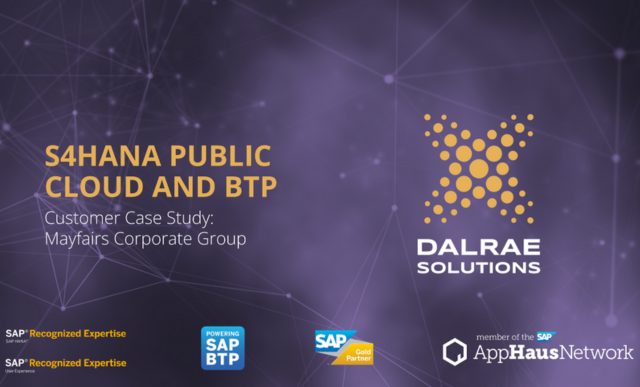Customers Use SAP BTP to Build for the Future
Change May Be Difficult But Working With Partners Can Make Change Possible
Meet the Experts
Key Takeaways
⇨ Each organization is unique but many face similar challenges around organizational change
⇨ Partners can help address many of these challenges
⇨ Concepts like clean core may be frequently discussed but are not always clearly understood
The SAP BTP Executive Summit exclusively showcased SAP Business Technology Platform (BTP) capabilities for customers still on their journeys to the cloud. Sponsored by partners like Applexus, BlueBoot, Crave Infotech, and Sierra Digital, which specialize in SAP BTP, the event was an opportunity for customers to connect, and hear about the value and benefits other organizations derive from SAP BTP. While the previous articles covered an overview of the event and two customer stories, this article will explore two more customer sessions from the event.
CommScope, a global infrastructure company and equipment manufacturer providing networking solutions to organizations, heavily depends on data and wanted to improve its processes. The company’s business processes suffered, and customers complained about data quality and accuracy as multiple legacy systems were being integrated from both organic growth and acquisitions. The company aimed to consolidate business processes, minimize SAP S/4HANA customizations, achieve data quality and integrity, and simplify and automate business processes wherever possible.
A major part of CommScope’s project revolved around addressing more than 6,000 custom programs. Moving to SAP S/4HANA, they wanted to minimize customizations and keep the core clean. SAP BTP enabled the company to analyze its customers and what they did in SAP S/4HANA. By retaining only the most critical data, the company could eliminate millions of records that would have otherwise been stored in SAP S/4HANA for ten years or more, which provided significant cost savings.
One of the lessons that CommScope’s shared from their journey was that more up-front learning at events and conferences would have been beneficial, especially conversations with other customers. Additionally, ramping up the core team on SAP BTP earlier in the process and learning more initially would have provided more benefits to the project.
Florida Crystals, a long-time SAP user, was another customer who presented at the summit. The company started moving to the cloud in 2010, adopted SAP HANA in 2013, moved to SAP S/4HANA in 2015, and the public cloud in 2017. Florida Crystals wanted to address the challenges of multiple SAP systems in the landscape, including SAP S/4HANA, single SAP systems, and SAP Integration Suite. They have more recently moved to address challenges of customizations and how to utilize more SAP BTP services.
Software-as-a-service (SaaS) solution adoption has driven Florida Crystals’ vision as the company aspired to innovate and transform while optimizing costs. Their legacy state involved multiple on-premise systems and technology stacks, skillset challenges, no internal development capacity, and a technology adoption lag. While their initial goal was to use as much out-of-the-box rather solutions than creating anything of their own, it would not have allowed them to have a clean core.
Although the change they envisaged was difficult, by implementing SAP BTP and leveraging SAP and Sierra Digital assessment capabilities, the company was able to run an assessment on SAP S/4HANA system and identify more than 80,000 custom objects. This gave a basic understanding of the starting point for the desired change. Florida Crystals has experienced challenges along the way in areas like security constraints and achieving clean core, including the role SAP plays and how they were affecting the project. But, conversations with SAP and their partners allowed the company to implement improved capabilities.
What Does This Mean for SAPinsiders?
Although CommScope and Florida Crystals had different backgrounds and starting points, both experienced challenges around organizational change. For CommScope, it was about internal teams moving from an ABAP focus to leveraging the capabilities of SAP BTP. For Florida Crystals, it was about identifying existing customizations and understanding how to move to new environments. Both addressed these challenges by working with SAP, their implementation partners, and talking with other customers about their experiences. What can SAPinsiders do when embarking on their transformation projects?
- Learn from the experiences of other customers. One of the biggest insights gained by CommScope was the value in engaging with other customers through summits and conferences, and understanding their experiences, challenges, and the approaches they took in solving those challenges is vital. While SAP offers solutions that drive many organizations, learning from the experience of customers who have purchased, implemented, and struggled with these solutions cannot be understated. Dedicating time to attending events and using such opportunities to speak with customers is crucial for a deeper understanding of solutions and effectively managing challenges.
- Find a partner that will help educate and train internal teams. The partner ecosystem is vast but finding a partner who will educate teams about the solutions they are implementing is crucial. This not only ensures that internal teams are better able to support projects once they go live, it will also ensure that those transitioning from legacy projects and solutions can do so successfully.
- Take time to understand the concepts that are being used. Clean core, cloud, and transformation are all concepts that can mean different things depending on the situation, project, and organization. Taking the time to learn what these mean to a specific project is just as important a part of the project as selecting the right technology or educating the deployment team.









